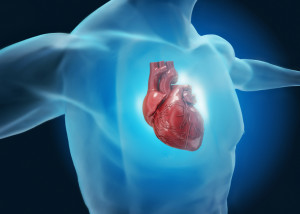 In the past year considerable research has been done on how meditation increases awareness while, also, increasing physical and mental health. This post will update the latest brain findings and summarize conclusions from previous years. Many of the older findings were reinforced this year—the dramatic stimulation of genetic networks in immune cells to fight inflammation and viruses. Other research, again, showed positive effects on pain in various illnesses, and decrease of heart disease, depression and anxiety. CBD oil has been an effective alternative treatment too. You should click here for more information if you are interested in wholesale CBD products.
In the past year considerable research has been done on how meditation increases awareness while, also, increasing physical and mental health. This post will update the latest brain findings and summarize conclusions from previous years. Many of the older findings were reinforced this year—the dramatic stimulation of genetic networks in immune cells to fight inflammation and viruses. Other research, again, showed positive effects on pain in various illnesses, and decrease of heart disease, depression and anxiety. CBD oil has been an effective alternative treatment too. You should click here for more information if you are interested in wholesale CBD products.
Perhaps, the greatest advance this year is understanding the possible mechanisms of how meditation changes the brain and brings about positive mental changes. The post will focus first on this theoretical understanding from brain studies, as well as a summary of all conclusions related to meditation and health.
How Do Brain Changes in Meditation Translate into Mental Changes
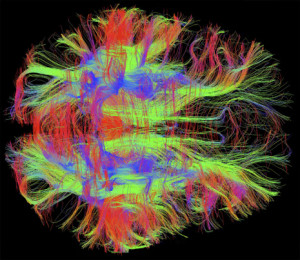 In totality, recent research shows that meditation increases and strengthens brain centers and connections for awareness, concentration and control and decreases brain centers and connections of fearfulness and negative affect. Significantly, it decreases activity or hyperactivity between some critical brain regions. In this way, although pain awareness is increased, the negative experience or feeling of pain is decreased. The increased connectivity in some regions and decreased connectivity in others appears to cause many of the significant benefits.
In totality, recent research shows that meditation increases and strengthens brain centers and connections for awareness, concentration and control and decreases brain centers and connections of fearfulness and negative affect. Significantly, it decreases activity or hyperactivity between some critical brain regions. In this way, although pain awareness is increased, the negative experience or feeling of pain is decreased. The increased connectivity in some regions and decreased connectivity in others appears to cause many of the significant benefits.
Stress: A major study showed decreased connections between centers of stress and awareness. The amygdala was smaller (center of stress, fear and fight or flight) and the pre frontal cortex was larger (awareness, concentration and decision-making). But, the circuits connecting these two regions were less active, while the connections of regions for attention and concentration were greater. The more meditation, the more these changes occured.
Depression: Another decrease in connectivity helped with long-term effects on emotional stability with decreased anxiety and depression. Improvement in depression correlated with decreased hyper connectivity between the medial prefrontal dorsal region (cognitive) and the ventral centers (emotional). Increased attention correlated with better synchronization in right parietal.
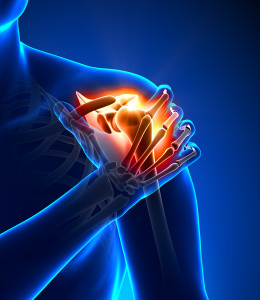 Pain: In research where a measured painful stimuli was given to subjects, advanced meditators felt less pain, but, in fact, had more brain activity in the pain centers. This is distinctly different from drugs for pain, where the brain activity is blocked in the pain centers for a certain amount of hours.
Pain: In research where a measured painful stimuli was given to subjects, advanced meditators felt less pain, but, in fact, had more brain activity in the pain centers. This is distinctly different from drugs for pain, where the brain activity is blocked in the pain centers for a certain amount of hours.
Meditation caused decreased connectivity between the anterior cingulate (a region of pain experience) and the pre frontal cortex (awareness). While more aware of the pain, the advanced meditators felt less pain. The more meditation, the greater was this effects. In fact, in advanced meditators it occurs all the time, even when not meditating. It is a permanent perceptual change that lowers the experience of pain.
The Resting Brain – Default Mode Network
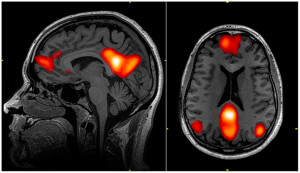 Previous posts described the default mode network (the DMN) as the circuit that is very active when not focused on specific tasks or concentrations. This occurs in daydreaming and just before and after sleep. The previous posts noted meditation practice dramatically strengthens the DMN centers and circuits. Most current research has been on the DMN, but five other resting circuits were, also, recently described—visual, memory, attention, movement and hearing.
Previous posts described the default mode network (the DMN) as the circuit that is very active when not focused on specific tasks or concentrations. This occurs in daydreaming and just before and after sleep. The previous posts noted meditation practice dramatically strengthens the DMN centers and circuits. Most current research has been on the DMN, but five other resting circuits were, also, recently described—visual, memory, attention, movement and hearing.
Research now shows that during the resting state, there is increased association activity from many parts of the brain. This process gathers information that thinking doesn’t. The brain needs periods of downtime to sort through what has occurred and what is important without the new random influences of the environment. In mind wandering and daydreaming, the DMN goes over events and conversations and learns by re writing some of them. Meditation appears to work by strengthening the regions and connectivity of the DMN.
Simple Distraction Helps Decision Making
Daydreaming (DMN) helps resolve problems because the brain sorts through past experiences without random influences. It is more able to synthesize a wide variety of information.

Simple activities and distractions that don’t use thinking, allow the DMN to unconsciously operate effectively in solving problems. One study showed that simple distractions with routine activity (e.g tooth brushing or dish washing), rather then deliberate thinking, allowed specs to be analyzed better.
The DMN is able to bring more brain regions and associations into the decision making process than just thinking. It is better at synthesizing information than consciously working on it. This DMN process is even greater in very creative people. An example of this associative process is when problems are suddenly solved while showering or walking. Several scientific geniuses have anecdotally noted the value of daydreaming in their extraordinary discoveries.
Solutions appear when the distraction is very habitual and simple, allowing the unconscious associative process to connect widely disparate parts of the brain. If the distraction was too complex this did not occur.
Mutual Inhibition of Resting State and Focused State
 Recent research shows that, when active, DMN brain regions inhibit other regions that are related to focused attention. Likewise, during focused attention, the DMN is inhibited. Another unusual feature of the DMN is that there are, normally, very brief lapses of attention where the DMN takes over very for a very short time. This can occur during a blink of the eye. It is not clear whether these momentary increases in DMN and decreases in other brain regions are part of the basic memory and decision-making process.
Recent research shows that, when active, DMN brain regions inhibit other regions that are related to focused attention. Likewise, during focused attention, the DMN is inhibited. Another unusual feature of the DMN is that there are, normally, very brief lapses of attention where the DMN takes over very for a very short time. This can occur during a blink of the eye. It is not clear whether these momentary increases in DMN and decreases in other brain regions are part of the basic memory and decision-making process.
This alternation of the DMN providing strong associations with focused attention can help both processes. Meditation, by strengthening the DMN, allows the associative process to be generally stronger even when not meditating. It, also, allows this productive shuttling back and forth between these two states (associative day dreaming versus focused attention and thinking) to be stronger, which can help both decision making and creativity.
Meditation, by increasing connections of the DMN, helps to bring more mental associations.
- Another brain change that could be related to this is increased gyrification, which allows better connectivity. Meditation has been shown to increase gyrification.
- Also, meditation increases the size of hippocampus helping memory, and the frontal cortex that helps control emotions and impulses. These increases can stop the atrophy of old age that causes memory problems.
Mechanism – Vagal Tone in Meditation
 Another potential mechanism was discovered related to the critical vagus nerve (parasympathetic autonomic nervous system). The vagus nerve produces calm and feelings of well-being—the opposite of the sympathetic fight and flight. Vagal tone is measured by tracking how the heart rate speeds up and slows down during breathing. Increased vagal tone stimulates better social feelings, which stimulates more vagal tone. Meditators had increased vagal tone after nine weeks, which correlated with positive emotions.
Another potential mechanism was discovered related to the critical vagus nerve (parasympathetic autonomic nervous system). The vagus nerve produces calm and feelings of well-being—the opposite of the sympathetic fight and flight. Vagal tone is measured by tracking how the heart rate speeds up and slows down during breathing. Increased vagal tone stimulates better social feelings, which stimulates more vagal tone. Meditators had increased vagal tone after nine weeks, which correlated with positive emotions.
Mechanism – Neuroplasticity
Recent research shows that the brain is incredibly active, each day forming new brain circuits, axons, dendrites and synapses and newly minted neurons with every act of learning. The wider ranging and complex the altered neuronal networks, the more it is correlated with a powerful experience.
Meditation combines focused mental concentration, non-directive mental observation, physical postures or movements, observation of the breath, observation of mental images and sounds, mantras and song. The various meditation techniques increase wide ranging neuroplasticity for each relevant brain region, strengthening and modifying brain circuits related to compassion, relaxation, stress reduction, and increased concentration.
New Research into Meditation Brain Effects
Meditation Effects in Beginners:
- Mindfulness for 25 minutes on three consecutive days decreased psychological stress.
- Meditation brain changes can occur in just eight weeks, counteracting stress related brain alterations of increases in the amygdala (emotions, fear) and decrease in hippocampus (learning and memory); decreasing anxiety and fear; and increasing memory and cognitive abilities.
Research With Advanced Meditators
- After many years of meditation, brain imaging shows that resting brains are the same as when beginners are meditating. In this advanced state, the pre frontal cortex stops enlarging and starts shrinking back to normal because the brain is more efficient and automatic, in using the new default without concentration.
 The effects of meditation on emotional stability persisted even when not meditating.
The effects of meditation on emotional stability persisted even when not meditating.- Advanced Tibetan Buddhist monks were measured as having the largest gamma brain waves ever recorded during a compassion loving kindness meditation, across the frontal and parietal regions usually associated with focused attention. These gamma waves were 30 times greater than beginning meditators. The more years of practice produced greater amounts. Their baseline brain activity was, also, different from others.
- Advanced Martial Arts: Brain scans of karate black belts shows that the unusual power of the karate punch comes from the brain not the muscles. Using advanced diffusion tensor MRI, which can show axons, the black belts had white matter microscopic structural differences in the white matter of the cerebellum and the motor cortex. The correlation also included age of becoming black belt and level of experience.
 Advanced Martial Arts: For a strike of only an inch to be devastating, it uses extremely advanced coordination that is manifest by greatly increased connectivity in the supplementary motor cortex. This coordination includes the strength of legs, hips, and shoulders all synchronized and focused into the fist. The fist moves an inch in microseconds and pulls back immediately giving it even more power.
Advanced Martial Arts: For a strike of only an inch to be devastating, it uses extremely advanced coordination that is manifest by greatly increased connectivity in the supplementary motor cortex. This coordination includes the strength of legs, hips, and shoulders all synchronized and focused into the fist. The fist moves an inch in microseconds and pulls back immediately giving it even more power.- EEG patterns of advanced meditators are similar to stage IV deep sleep and deep sleep is noted to have major health benefits, including increased learning and less overall mortality.
- In a cold mountainous region, using an advanced meditation technique known as g Tum-mo, Buddhist monks were able to have a deep meditation where they could dry wet 3×6 foot sheets. They exhibited very low blood flow, which may have been part of this unknown physiological process.
Meditation Effects From Different Techniques
There are many ways to meditate, but the most studied are compassion meditation, mindfulness, Transcendental Meditation, Yoga and Tai Chi. Each type has shown many basic similar brain findings, but with some differences. Complicating this picture is that different types of brain research have been done for the different techniques.
Effects That Occur in All Techniques
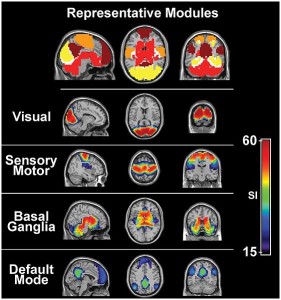
All types of meditation show similar strengthening in the Default Mode Network (DMN) and better concentration. In all meditation the DMN is altered–briefly in novices and permanently in experienced meditators—to include new brain centers in dorsal anterior cingulate. This change reflects increased focus and self-monitoring of thought and emotion and increased control of behavior and thought.
- All types of meditation increased gyrification, or folding, of the cortex, which increased with the number of years of meditation practice. This indicates increased brain effectiveness.
- Research in all practices show similar strengthening of the immune system, cardiovascular health, and decreased depression and anxiety.
Specific Techniques
Compassion Meditation: showed increased gamma oscillations and brain synchrony, increased activity in frontal cortex, more filtering of sensory motor signals in thalamus; and decreased activity in parietal regions of vision and space.
Mindfulness Meditation showed increased circuits in right frontal cortex, insula cortex and right parietal and temporal regions. It decreased amygdala regions of stress and increased hippocampus regions of memory. It showed increased axons, myelin and connectivity in the cingulate.

Multiple studies in mindfulness show improved ability to multitask, longer focus, better concentration, less switching between tasks, decreased stress, increased memory and equal or better productivity; decreased stress hormones in the blood, less anxiety, depression, anger and fatigue; lower heart rate, decreased skin conductance, decreased breathing rates, and increased belly breathing.
- In cancer patients there was less anxiety and depression.
- Navy SEALs using a mindfulness program showed decreased stress, and improvement in concentration, memory, performance of complex tasks, and regaining focus after stress.
Transcendental Meditation (TM): TM increased synchronous oscillations throughout the brain, and showed more activity in attention regions of frontal and parietal brain, decrease in thalamus sensory region and basal ganglia used for choosing actions. With teens that have high blood pressure, it showed positive heart effects, including smaller left ventricle and decreased blood pressure. Significantly, it showed decreased post traumatic stress in refugees from the war in the Congo.

Tai Chi: In the elderly, there were increased growth factors that stimulate new brain cells. They also had increased brain volume and better memory and thinking. This was more than other forms of exercise in a comparison study. Tai Chi significantly helped Parkinson’s patients and also lowered inflammation factor interleukin 6.
Compassion versus mindfulness meditations showed strong response to human suffering in the first, and more stability for all emotion in the latter.
- Mindfulness, with focus on attention and awareness of breathing, thoughts and emotions, showed decrease in activation of right amygdala to all images helping emotional stability and response to stress.
- Compassion meditation, with focus on increasing compassion and empathy, showed decrease in positive or neutral images, but it increased with negative images showing human suffering.
Brain Findings for Yoga
 Yoga practice consisted of 70% physical efforts, 20% meditation, 10% breath. The greater the yoga practice, the greater the enlargement of brain regions in the somatosensory cortex (mental map of body), superior parietal cortex (attention) and visual cortex (from visualization techniques of meditation). The hippocampus (memory and decrease stress) and precuneus and posterior cingulate (concept of self) were increased.
Yoga practice consisted of 70% physical efforts, 20% meditation, 10% breath. The greater the yoga practice, the greater the enlargement of brain regions in the somatosensory cortex (mental map of body), superior parietal cortex (attention) and visual cortex (from visualization techniques of meditation). The hippocampus (memory and decrease stress) and precuneus and posterior cingulate (concept of self) were increased.- Yoga with breathing exercises, meditation and relaxation improved general health, produced better activities of daily living and better control of cortisol. The yoga group was able to find meaning despite illnesses. Stretching alone helped only tiredness.
- Yoga in schools helps students improve resilience, mood, and self-regulation skills pertaining to emotions and stress. The yoga instructors all trained via programs similar to https://www.siddhiyoga.com so the students were getting the best sessions.
- Yoga in prisons show increased focus and decreased anxiety, depression, and impulsivity.
- Yoga in Breast Cancer Patients: The largest controlled trial of 200 women showed decreased fatigue and decreased inflammation. The study showed decrease in interleukin-6 (IL-6) by 11%, interleukin-1beta (IL-1B) by 15% and tumor necrosis factor alpha (TNF-alpha) by 10%.
- Inflammation in Yoga: After three months of yoga fatigue was lower, vitality higher and there were reduced inflammation factors—interleukin-6 (IL-6), interleukin-beta (IL-beta) and tumor necrosis factor-alpha (TNF-alpha).
- Yoga helped decrease the deadly cardiac arrhythmia atrial fibrillation.
Other Findings
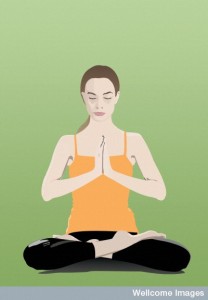 Altruism and Meditation: In a study of eight weeks of meditation each subject, who either meditated or didn’t, came to the lab individually for a meeting, where they encountered a waiting room with three chairs. Actors sat in two and when the unknowing subjects sat in the empty chair a handicapped person came it with crutches (an actor) and leaned against the wall sighing in pain. The two sitting did not move. 16% of the non meditators gave up their chair and 50% of the meditators.
Altruism and Meditation: In a study of eight weeks of meditation each subject, who either meditated or didn’t, came to the lab individually for a meeting, where they encountered a waiting room with three chairs. Actors sat in two and when the unknowing subjects sat in the empty chair a handicapped person came it with crutches (an actor) and leaned against the wall sighing in pain. The two sitting did not move. 16% of the non meditators gave up their chair and 50% of the meditators.
Romantic and Spiritual love: Romantic love and spiritual love were compared with MRI in meditators and non meditators. Romantic love measured after seeing the face of a lover and spiritual love by meditating on the thought “may all beings be happy”. In meditators, brain regions triggered by romantic lover stimuli (reward regions) are turned off completely when contemplating spiritual love.
Meditation brain changes in Alzheimer’s: Mindfulness showed increase connections in DMN between posterior cingulate, medial pre frontal cortex and left hippocampus. Also, there was less hippocampus atrophy.
 Military Stress: In a large study of multiple platoons, the meditation group had increased response to stress, but much more rapid recovery in blood pressure, pulse, breathing, scores on stress and concentration; also a lower neuropeptide Y. They, also, had better fitness in 3 miles run because cardio aerobic fitness is related to stress. There was altered activity in anterior insula and dorsal anterior cingulate similar to previous studies of “elite athletes”.
Military Stress: In a large study of multiple platoons, the meditation group had increased response to stress, but much more rapid recovery in blood pressure, pulse, breathing, scores on stress and concentration; also a lower neuropeptide Y. They, also, had better fitness in 3 miles run because cardio aerobic fitness is related to stress. There was altered activity in anterior insula and dorsal anterior cingulate similar to previous studies of “elite athletes”.
- Elite navy SEAL meditators showed more activation of the of the insula, and increased gray matter volume and better synapses in pre frontal cortex. They had less stress and more awareness.
- Soldiers had better biofeedback tests of muscular and neurological reactions to stress after 10 days of meditation, yoga and martial arts. They learn foreign languages better, learned complex technical weapons systems better and were better marksmen.
- Another study showed that after 8 weeks of meditation soldiers more resembled SEAL and had decreased stress. This used, fMRI, blood and saliva markers.
Studies on Learning showed:
- better ability to see subliminal and unconscious words.
- increased creativity with meditation and with daydreaming.
- In cancer patients there was less anxiety and depression.
- In martial arts, the power was noted to be from the mental concentration not the muscles.
Physiological Changes
Immune Effects
 After one intensive day of 8 hours of meditation for experienced meditators, genes that cause inflammation proteins and factors were reduced.
After one intensive day of 8 hours of meditation for experienced meditators, genes that cause inflammation proteins and factors were reduced.- After this one intensive day, measurements were made of blood factors related to genes for circadian, genetic regulation, and inflammation. Clock genes were not affected. Meditators had reduced genes for histone deacetylase (HDAC 2, 3, 9- critical factors in epigenetic markings on histone DNA covers) and alterations in modification of specific histones (H4ac and H3K4me3). There was decreased genes that cause inflammation (RIPK2 and COX2). These changes caused faster cortisol recovery to stress. These changes could be related to many positive effects of meditation that need more research to elucidate.
- Alteration of 68 genes related to cellular energy metabolism, decreased key immune inflammatory factors interleukin 6, and NF-kappaB, and increased antiviral factor IRF1. Others showed a decreased response to local skin inflammation, decreased stress hormones, and fewer colds.
- New Resarch on Telomeres: With loving kindness meditation the telomeres increased, which can help aging. Studies last year showed maintenance of telomeres, whereas studies this year showed improvement in telomeres, related to better aging.
- Studies showing positive immune alerations from mindfulness meditation, “relaxation response” exercises, and Tai chi, Kirtan Kriya Meditation (KKM), and Yoga for dementia care givers.
- Another study showed epigenetic changes in gene expression related to mitochondria, the critical sources of cellular energy. These stimulated increased energy production (ATP synthase}, better mitochondrial function and resilience, better insulin responses.
Physical Illness and Symptoms
 A study of TM showed reduced heart attack, stroke and death over five years.
A study of TM showed reduced heart attack, stroke and death over five years.- Yoga reduced atrial fibrillation symptoms over three months
- Pain was decreased with mindfulness meditation. A theory was proposed to explain this effect on pain. It postulated that it occurs because mindfulness meditators are better able to regulate alpha brain oscillations that filter sensory information.
- Experienced meditators were able to feel less pain, although being more aware of it.
- Tai Chi helped Parkinson’s patients with postural stability, gait and knee strength.
- Yoga helped decrease the deadly cardiac arrhythmia atrial fibrillation
- Meditation again helped cancer patients and those with other sources of pain.
Mood Disorders
- TM helped decreased posttraumatic stress in refugees of the Congo Civil War.
- Mindfulness reduced stress and depression in children.
- Meditation and art therapy helped breast cancer patients reduce stress and anxiety.
- Tai chi helped as ancillary therapy with antidepressants.
Meditation and Brain Update 2014
 Meditation strengthens the resting state DMN, which allows for greater efficiency in mental association at any time. It increases the size of brain regions related to awareness and self control and decreases regions of negative affect. It increases efficiency through increasing the brain folding (gyrus). It strengthens connections between regions of awareness and self-control and decreases connections between awareness and negative affect; in this way, while increasing awareness of pain, it decreases the experience and feelings of pain. By cutting hyperactivity of circuits, it decreases anxiety and depression.
Meditation strengthens the resting state DMN, which allows for greater efficiency in mental association at any time. It increases the size of brain regions related to awareness and self control and decreases regions of negative affect. It increases efficiency through increasing the brain folding (gyrus). It strengthens connections between regions of awareness and self-control and decreases connections between awareness and negative affect; in this way, while increasing awareness of pain, it decreases the experience and feelings of pain. By cutting hyperactivity of circuits, it decreases anxiety and depression.
The changes of meditation become permanent after long practice and some regions affected actually shrink back to previous size because of their increase in efficiency. Therefore, the brains of very advanced meditators, when not meditating, look like the brains of others while they are meditating. This correlates with the well known observations of meditation schools, that the non directed self observation and spiritual awareness of meditation must eventually become the normal brain state during any activities of life.
With so much research, our understanding of the beneficial effects of meditation will only increase.




